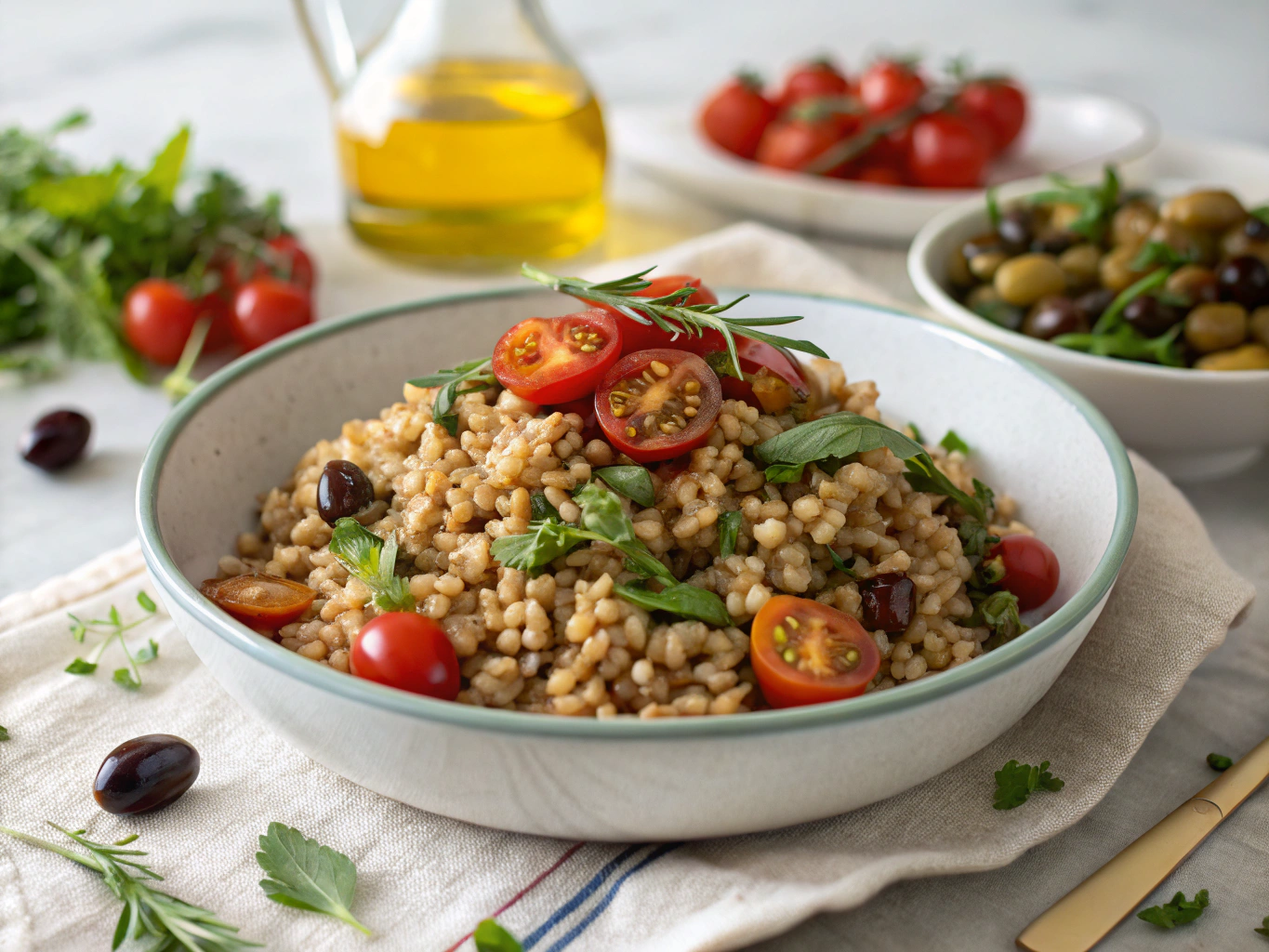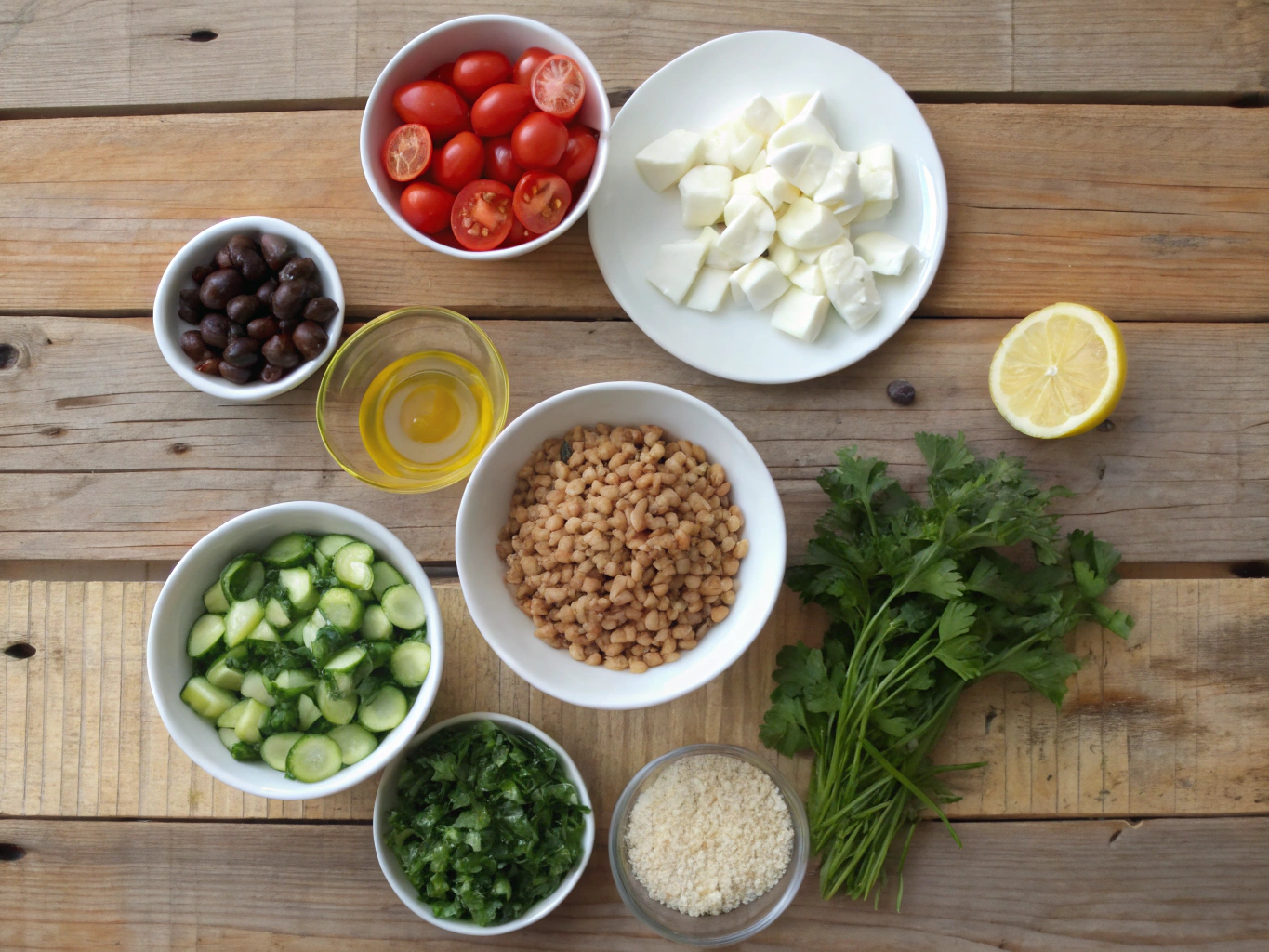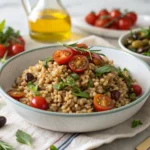
Table of Contents
There’s something deeply nostalgic about a well-prepared farro side dish. I remember the first time I tasted farro—it wasn’t at a fancy restaurant or trendy café. It happened one chilly Sunday afternoon in Portland as I was experimenting with whole grains for a client dinner party. I’d just transitioned into full-time plant-based cooking and was looking for something earthy, nutty, and versatile.
Once I tossed that batch of cooked farro with roasted garlic, sun-dried tomatoes, and fresh parsley, I knew I’d found a new favorite. Since then, farro side dishes have become a staple in my kitchen—and they just might become one in yours too. In this article, we’ll explore what makes farro special, how to make it unforgettable, and why it deserves a permanent place at your table.
Why Farro Side Dish Makes a Standout Choice
The Grain That Brings Depth and Texture
Farro isn’t your average grain. This ancient wheat variety boasts a chewy texture and nutty flavor that complements just about everything. It has a satisfying bite that holds up well in both warm and cold preparations. Whether you serve it in a simple bowl or as part of a loaded grain salad, a farro side dish adds rustic flair and hearty nutrition to any spread.
When I first started experimenting with farro, it quickly replaced other grains in numerous recipes. Compared to white rice or pasta, farro contains more fiber and protein, making it a smart, plant-forward choice. Want proof? Just try it in our spring farro salad with herbs and lemon, and you’ll see how it easily transforms from humble to high-end.
Nostalgia Meets Nutrient-Dense Innovation
Serving farro reminds me of childhood Sundays when my mom would stew lentils and roast vegetables straight from our garden. Back then, grains like farro didn’t have the spotlight. Today, with its impressive nutrient profile and earthy flavor, farro makes a beautiful canvas for seasonal ingredients.
I’ve used farro as the base for modern takes on comfort classics. In fact, our turkey farro soup has become a year-round favorite among my clients. It’s approachable, deeply satisfying, and flexible depending on the ingredients you have on hand.
Whether it’s in a vibrant cranberry farro salad or combined with legumes in our farro lentil salad, farro consistently delivers on taste, texture, and nutrition.
Make Your Own Easy Farro Side Dish
Ingredients List for Farro Side Dish

Creating a farro side dish doesn’t require a culinary degree, just a few pantry staples and a bit of love in preparation. Here’s my base recipe that you can adapt based on what’s in your fridge today.
| Ingredient | Note / Substitutes |
|---|---|
| 1 cup farro (pearled preferred) | Can swap with spelt berries for similar texture |
| 2 cups vegetable broth | Or water + 1 tsp bouillon |
| 3 tbsp olive oil | Extra virgin preferred |
| 1 clove garlic, minced | Optional, adds depth |
| 1/2 tsp sea salt | Adjust to taste |
| Chopped fresh herbs (parsley, mint, or dill) | Add brightness and freshness |
If you’re feeling adventurous, try mixing in chopped olives, lemon zest, or even roasted veggies from last night’s dinner. Farro plays well with any flavor profile.
Timing Breakdown
Total Time: 40 minutes | Prep Time: 5 minutes | Cook Time: 35 minutes
Compared to brown rice (which averages 50 minutes), pearled farro is a time-saver—finished in around 35 minutes while retaining its signature chew. Quick-soaked overnight farro or semi-pearled varieties can reduce cook time even further. Always check your packaging for timing specifics, as cooking farro is sometimes like making pasta: boil, drain, and toss.
Step-by-Step Instructions
- Rinse the farro under cold water to remove any dust or grit.
- In a saucepan, combine 1 cup farro and 2 cups broth. Bring to a boil over high heat.
- Reduce heat to low, cover, and simmer for 30–35 minutes. The grains should be tender but maintain a firm bite.
- Drain any excess liquid and fluff with a fork.
- In a skillet, heat olive oil over medium heat. Add garlic and sauté until fragrant—roughly 1 minute.
- Stir the cooked farro into the skillet. Season with salt, pepper, and chopped herbs.
- Taste and adjust seasoning. Serve warm or at room temperature.
Looking for more bold flavors? Toss this seasoned farro into our crowd-pleasing vegetarian farro recipes for endless variations.
Boosting Nutrition & Pairing Possibilities
Build the Perfect Balanced Plate
Farro makes the perfect sidekick to everything from roasted mushrooms to grilled veggie skewers. Because it’s rich in fiber, iron, magnesium, and protein, it helps round out any plant-based entrée. A single serving offers up to 8g of protein and 40g of complex carbs, supporting sustained energy and satiety.
For anyone looking to stabilize blood sugar or incorporate more complex grains into their diet, farro is a solid choice. According to the Harvard School of Public Health, whole grains like farro can lower inflammation and reduce the risk of chronic diseases.
Want a hands-off idea? Pair farro with grilled eggplant or drizzle it with tahini and lemon for a Mediterranean vibe. We’ve also elevated farro by combining it with marinated vegetables in our Charlie Bird’s farro salad.
Farro for All Seasons
Fall calls for roasted squash and cranberries, while spring welcomes radishes, peas, and herbs. The beauty of a farro side dish lies in its year-round adaptability. It tastes just as good served warm from the stove as it does chilled the next day for lunch.
If you’re planning ahead, try a cold preparation like our Mediterranean farro salad recipe. It keeps well in the fridge and only gets better after a day of marinating.
And if you love earthy flavors? Elevate any meal with our best farro bowl recipes featuring seasonal produce and global spices.
Creative Variations and Meal Planning Tips
One Grain, Many Meals
Farro is a fantastic batch-cooking grain. Make a big pot on Sunday and use it multiple ways throughout the week. Start with a farro side dish, then repurpose leftovers into grain bowls, burritos, or even casseroles. For crunch, toast it briefly in a pan with olive oil before serving.
Combining farro into soups or stuffing bell peppers with lentils and cooked farro is another creative way to prevent kitchen fatigue.
Family-Friendly Flavor Hacks
Trying to get younger eaters on board? Add roasted carrots, a touch of maple, or a sprinkle of vegan Parmesan for instant appeal. You’d be surprised how adaptable farro is to subtle sweetness and fun toppings. It’s a great way to replace more processed sides without sacrificing flavor.
Meanwhile, spicy eaters can enhance it with harissa, lemon zest, or chili flakes. Regardless of your family’s preferences, farro finds a way to fit in.
FAQs
How do you cook farro as an easy side?
Rinse the farro under cold water, then cook it in a 2:1 ratio of broth or water, simmering covered for 30–35 minutes. Drain excess liquid and season to taste. For extra flavor, sauté with garlic and herbs before serving.
What entrées pair well with farro?
Farro works beautifully with grilled vegetables, tofu, legumes, and roasted root veggies. It’s especially good next to Mediterranean dishes, stews, or even on its own with a drizzle of lemon tahini dressing.
Is farro cooked like rice or pasta?
Depends on the type. Pearled farro often cooks like pasta—boil and drain. Whole and semi-pearled versions require simmering like rice with measured water and covered cooking.
Does farro need seasoning when served plain?
Yes! Unsalted farro can taste bland. Adding sea salt during boiling or tossing it with sautéed garlic, olive oil, lemon, or herbs ensures maximum flavor.
Conclusion
A flavorful farro side dish delivers comfort, heartiness, and nutrition with every bite. It’s an easy upgrade from white rice or couscous—and works as a blank canvas for spices, herbs, and fresh seasonal ingredients. In our plant-based kitchen, farro is more than just a side—it’s a story in every spoonful.
By prepping farro ahead and seasoning thoughtfully, you’ll find countless ways to enjoy it all week long. From warm comforting bowls to zesty salads, farro adapts and elevates any meal. And best of all, it brings healthful, slow food satisfaction back to our tables—just like the Sundays I grew up with.
Print
Flavorful & Simple Farro Side Dish Ideas You’ll Crave Again
- Total Time: 40 minutes
- Yield: 4 servings 1x
- Diet: Vegan
Description
A hearty, nutty, and versatile side dish featuring pearled farro, olive oil, garlic, and fresh herbs. Perfect served warm or chilled, it pairs beautifully with a variety of seasonal and Mediterranean-inspired mains.
Ingredients
1 cup farro (pearled preferred) — can swap with spelt berries
2 cups vegetable broth — or water + 1 tsp bouillon
3 tbsp olive oil — extra virgin preferred
1 clove garlic, minced — optional, adds depth
1/2 tsp sea salt — adjust to taste
Chopped fresh herbs (parsley, mint, or dill) — for brightness and freshness
Instructions
1. Rinse the farro under cold water to remove any dust or grit.
2. In a saucepan, combine 1 cup farro and 2 cups broth. Bring to a boil over high heat.
3. Reduce heat to low, cover, and simmer for 30–35 minutes until grains are tender but still chewy.
4. Drain any excess liquid and fluff with a fork.
5. In a skillet, heat olive oil over medium heat. Add garlic and sauté until fragrant, about 1 minute.
6. Stir the cooked farro into the skillet. Season with salt, pepper, and chopped herbs.
7. Taste and adjust seasoning. Serve warm or at room temperature.
Notes
For extra flavor, toss in chopped olives, lemon zest, or roasted vegetables.
Pairs well with Mediterranean dishes, grilled vegetables, tofu, or hearty salads.
Great for batch cooking — store in the fridge for up to 5 days.
- Prep Time: 5 minutes
- Cook Time: 35 minutes
- Category: Side Dish
- Method: Simmer + Sauté
- Cuisine: Mediterranean
Nutrition
- Serving Size: 1 cup
- Calories: 220
- Sugar: 1g
- Sodium: 300mg
- Fat: 9g
- Saturated Fat: 1.5g
- Unsaturated Fat: 7g
- Trans Fat: 0g
- Carbohydrates: 36g
- Fiber: 6g
- Protein: 8g
- Cholesterol: 0mg
Keywords: farro, grain side dish, healthy, plant-based, Mediterranean
